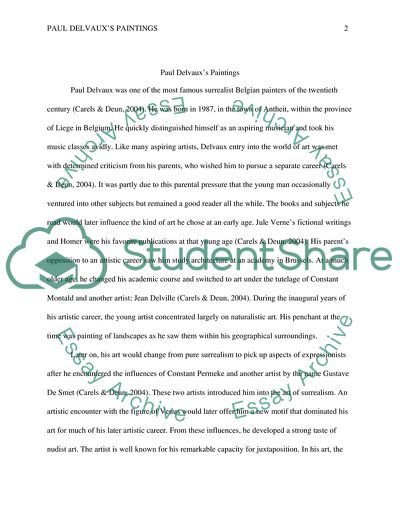Cite this document
(Paul Delvauxs Paintings Essay Example | Topics and Well Written Essays - 3000 words, n.d.)
Paul Delvauxs Paintings Essay Example | Topics and Well Written Essays - 3000 words. https://studentshare.org/visual-arts-film-studies/1784936-write-an-essay-on-the-work-of-one-artist-with-reference-to-a-maximum-of-five-art-works-by-the-artist-discuss-how-they-relate-to-a-particular-theme-in-hisher-oeuvre
Paul Delvauxs Paintings Essay Example | Topics and Well Written Essays - 3000 words. https://studentshare.org/visual-arts-film-studies/1784936-write-an-essay-on-the-work-of-one-artist-with-reference-to-a-maximum-of-five-art-works-by-the-artist-discuss-how-they-relate-to-a-particular-theme-in-hisher-oeuvre
(Paul Delvauxs Paintings Essay Example | Topics and Well Written Essays - 3000 Words)
Paul Delvauxs Paintings Essay Example | Topics and Well Written Essays - 3000 Words. https://studentshare.org/visual-arts-film-studies/1784936-write-an-essay-on-the-work-of-one-artist-with-reference-to-a-maximum-of-five-art-works-by-the-artist-discuss-how-they-relate-to-a-particular-theme-in-hisher-oeuvre.
Paul Delvauxs Paintings Essay Example | Topics and Well Written Essays - 3000 Words. https://studentshare.org/visual-arts-film-studies/1784936-write-an-essay-on-the-work-of-one-artist-with-reference-to-a-maximum-of-five-art-works-by-the-artist-discuss-how-they-relate-to-a-particular-theme-in-hisher-oeuvre.
“Paul Delvauxs Paintings Essay Example | Topics and Well Written Essays - 3000 Words”. https://studentshare.org/visual-arts-film-studies/1784936-write-an-essay-on-the-work-of-one-artist-with-reference-to-a-maximum-of-five-art-works-by-the-artist-discuss-how-they-relate-to-a-particular-theme-in-hisher-oeuvre.


